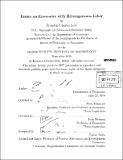| dc.contributor.advisor | Peter Diamond and Ivan Werning. | en_US |
| dc.contributor.author | Lehr, Brandon Charles | en_US |
| dc.contributor.other | Massachusetts Institute of Technology. Dept. of Economics. | en_US |
| dc.date.accessioned | 2011-04-25T15:52:54Z | |
| dc.date.available | 2011-04-25T15:52:54Z | |
| dc.date.copyright | 2010 | en_US |
| dc.date.issued | 2010 | en_US |
| dc.identifier.uri | http://hdl.handle.net/1721.1/62400 | |
| dc.description | Thesis (Ph. D.)--Massachusetts Institute of Technology, Dept. of Economics, 2010. | en_US |
| dc.description | Cataloged from PDF version of thesis. | en_US |
| dc.description | Includes bibliographical references (p. 131-133). | en_US |
| dc.description.abstract | In this thesis, I study two different economies that consist of heterogeneous labor. By allowing for differences among individuals where previous analyses restricted attention to homogeneous labor, I am able to understand the impact of such a consideration on issues of optimal policy and potential equilibria. The first chapter, Optimal Social Insurance with Individual Private Insurance and Moral Hazard, characterizes optimal social insurance in an economy where competitive firms also provide insurance to workers facing uncertain outcomes. An ex-ante heterogeneous population of workers exerts effort to increase the likelihood of high outcome events. This chapter is novel in its joint consideration of two sources of heterogeneity, two potential sources of insurance, and an endogenous ex-post distribution of outcomes. The introduction of ex-ante heterogeneity in the presence of optimal private insurance changes the optimal prescription for social insurance away from zero. Moreover, the relative source of the variation in outcomes due to ex-ante heterogeneity and ex-post shocks plays a significant role in the welfare loss associated with setting optimal social insurance without recognizing the presence of private insurance. The second chapter, Efficiency Wages with Heterogeneous Agents, builds a model of efficiency wages with heterogeneous workers in the economy who differ with respect to their disutility of labor effort. In such an economy, two types of pure strategy symmetric Nash equilibria in firm wage offers can exist: a no-shirking equilibrium in which all workers exert effort while employed and a shirking equilibrium in which within each firm some workers exert effort while others shirk. The type of equilibrium that prevails in the economy depends crucially on the extent of heterogeneity among the workers. In addition, it is shown that the characterization of the economy is independent of allowing for variable labor hours and the subsequent adverse selection problem it introduces, as there does not exist a pure strategy symmetric separating Nash equilibrium. Finally, in the third chapter I correct the proof of the main proposition in the analysis of an efficiency wage model with a continuum of heterogeneous agents constructed by Albrecht and Vroman (1998). | en_US |
| dc.description.statementofresponsibility | by Brandon Charles Lehr. | en_US |
| dc.format.extent | 133 p. | en_US |
| dc.language.iso | eng | en_US |
| dc.publisher | Massachusetts Institute of Technology | en_US |
| dc.rights | M.I.T. theses are protected by
copyright. They may be viewed from this source for any purpose, but
reproduction or distribution in any format is prohibited without written
permission. See provided URL for inquiries about permission. | en_US |
| dc.rights.uri | http://dspace.mit.edu/handle/1721.1/7582 | en_US |
| dc.subject | Economics. | en_US |
| dc.title | Essays on economies with heterogeneous labor | en_US |
| dc.type | Thesis | en_US |
| dc.description.degree | Ph.D. | en_US |
| dc.contributor.department | Massachusetts Institute of Technology. Department of Economics | |
| dc.identifier.oclc | 710813317 | en_US |
